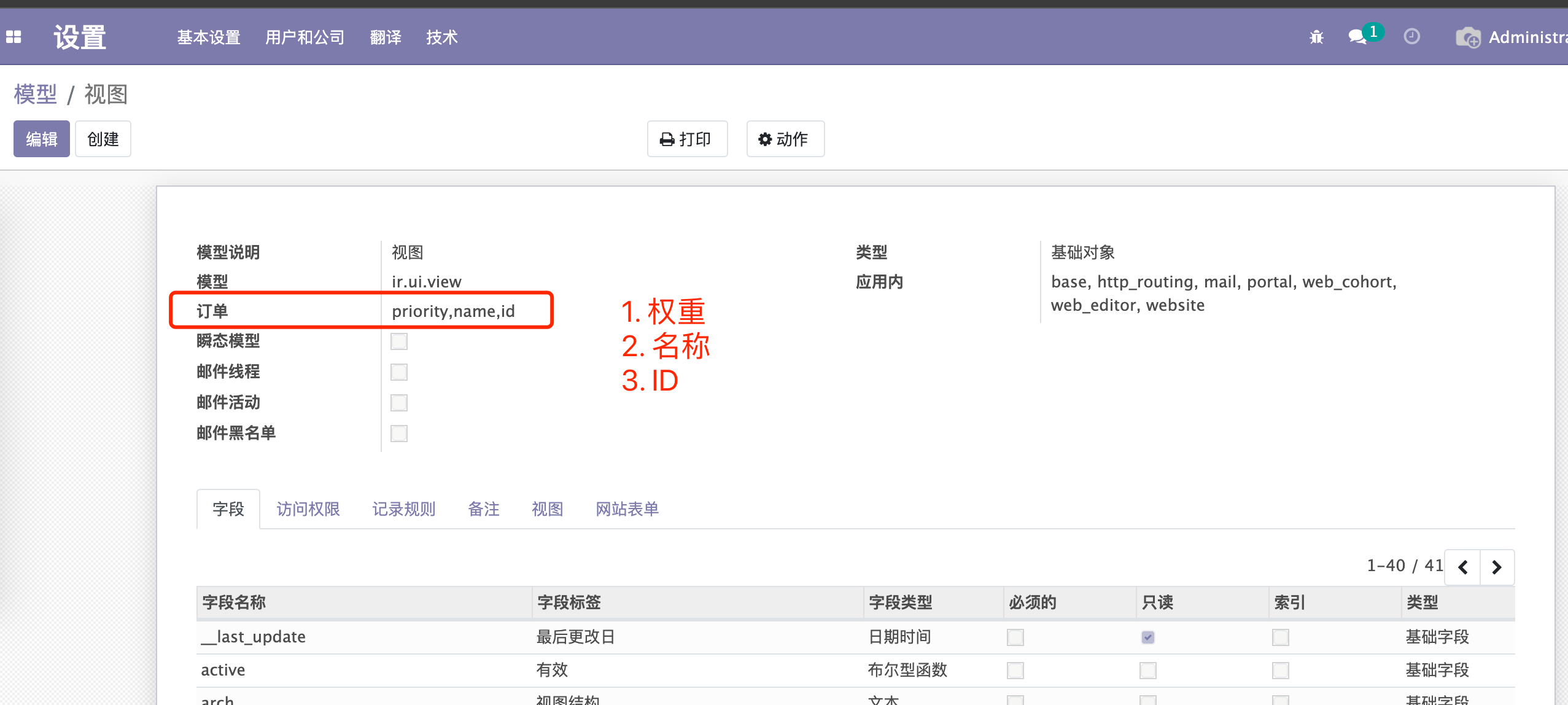背景:同一個模組,兩組開發人員對同一個模型的form檢視進行了二開。在沒有指定外部ID的情況下,odoo是如何選擇展示展示哪個檢視呢?
上乾貨
- odoo在載入檢視的時候,首先呼叫的models.py中的
load_views函式;
@api.modeldef load_views(self, views, options=None):""" Returns the fields_views of given views, along with the fields ofthe current model, and optionally its filters for the given action.:param views: list of [view_id, view_type]:param options['toolbar']: True to include contextual actions when loading fields_views:param options['load_filters']: True to return the model's filters:param options['action_id']: id of the action to get the filters:return: dictionary with fields_views, fields and optionally filters"""options = options or {}result = {}toolbar = options.get('toolbar')result['fields_views'] = {v_type: self.fields_view_get(v_id, v_type if v_type != 'list' else 'tree',toolbar=toolbar if v_type != 'search' else False)for [v_id, v_type] in views}result['fields'] = self.fields_get()if options.get('load_filters'):result['filters'] = self.env['ir.filters'].get_filters(self._name, options.get('action_id'))return result
- 上面的核心在
fields_view_get函式,如下,擷取重要的內容
@api.modeldef fields_view_get(self, view_id=None, view_type='form', toolbar=False, submenu=False):self.check_access_rights('read')view = self.env['ir.ui.view'].sudo().browse(view_id)# Get the view arch and all other attributes describing the composition of the viewresult = self._fields_view_get(view_id=view_id, view_type=view_type, toolbar=toolbar, submenu=submenu)···
- 檢查許可權通過後,呼叫
_fields_view_get函式,若使用者呼叫的檢視沒有指定檢視ID,那麼將呼叫預設的檢視
@api.modeldef _fields_view_get(self, view_id=None, view_type='form', toolbar=False, submenu=False):View = self.env['ir.ui.view'].sudo()result = {'model': self._name,'field_parent': False,}# try to find a view_id if none providedif not view_id:# <view_type>_view_ref in context can be used to overrride the default viewview_ref_key = view_type + '_view_ref'view_ref = self._context.get(view_ref_key)if view_ref:if '.' in view_ref:module, view_ref = view_ref.split('.', 1)query = "SELECT res_id FROM ir_model_data WHERE model='ir.ui.view' AND module=%s AND name=%s"self._cr.execute(query, (module, view_ref))view_ref_res = self._cr.fetchone()if view_ref_res:view_id = view_ref_res[0]else:_logger.warning('%r requires a fully-qualified external id (got: %r for model %s). ''Please use the complete `module.view_id` form instead.', view_ref_key, view_ref,self._name)if not view_id:# otherwise try to find the lowest priority matching ir.ui.viewview_id = View.default_view(self._name, view_type)if view_id:# read the view with inherited views appliedroot_view = View.browse(view_id).read_combined(['id', 'name', 'field_parent', 'type', 'model', 'arch'])result['arch'] = root_view['arch']result['name'] = root_view['name']result['type'] = root_view['type']result['view_id'] = root_view['id']result['field_parent'] = root_view['field_parent']result['base_model'] = root_view['model']else:# fallback on default views methods if no ir.ui.view could be foundtry:arch_etree = getattr(self, '_get_default_%s_view' % view_type)()result['arch'] = etree.tostring(arch_etree, encoding='unicode')result['type'] = view_typeresult['name'] = 'default'except AttributeError:raise UserError(_("No default view of type '%s' could be found !", view_type))return result
- 此處我們討論的是odoo是如何取預設檢視的,再進ir.ui.view模型的
default_view函式檢視
@api.modeldef default_view(self, model, view_type):""" Fetches the default view for the provided (model, view_type) pair:primary view with the lowest priority.:param str model::param int view_type::return: id of the default view of False if none found:rtype: int"""domain = [('model', '=', model), ('type', '=', view_type), ('mode', '=', 'primary')]return self.search(domain, limit=1).id
- 是不是很驚喜,毛都沒有,看不出來如何做的選擇。彆著急,看ir.ui.view的模型吧。

有點坑啊,大家在檢視繼承的時候。權重基本上是預設的,也就是說若不考慮name的影響,那麼預設檢視將永遠是最先新增的基礎檢視。但是,這裡name的排序居然還在ID的前面,這就有的玩了嘛,起名字也是門藝術了。
- 好了迴歸正題,在步驟3中,拿到了預設檢視後,我們取到的檢視有可能是繼承檢視,也有可能是基礎檢視。那麼將通過
read_combined函式拼接出來以基礎檢視為框架,包含所有繼承檢視內容的etree物件。
def read_combined(self, fields=None):"""Utility function to get a view combined with its inherited views.* Gets the top of the view tree if a sub-view is requested* Applies all inherited archs on the root view* Returns the view with all requested fields.. note:: ``arch`` is always added to the fields list even if notrequested (similar to ``id``)"""# introduce check_view_ids in contextif 'check_view_ids' not in self._context:self = self.with_context(check_view_ids=[])check_view_ids = self._context['check_view_ids']# if view_id is not a root view, climb back to the top.root = selfwhile root.mode != 'primary':# Add inherited views to the list of loading forced views# Otherwise, inherited views could not find elements created in their direct parents if that parent is defined in the same modulecheck_view_ids.append(root.id)root = root.inherit_id# arch and model fields are always returnedif fields:fields = list({'arch', 'model'}.union(fields))# read the view arch[view_data] = root.read(fields=fields)view_arch = etree.fromstring(view_data['arch'].encode('utf-8'))if not root.inherit_id:if self._context.get('inherit_branding'):view_arch.attrib.update({'data-oe-model': 'ir.ui.view','data-oe-id': str(root.id),'data-oe-field': 'arch',})arch_tree = view_archelse:if self._context.get('inherit_branding'):root.inherit_branding(view_arch)parent_view = root.inherit_id.read_combined(fields=fields)arch_tree = etree.fromstring(parent_view['arch'])arch_tree = self.browse(parent_view['id']).apply_inheritance_specs(arch_tree, view_arch)# and apply inheritancearch = root.apply_view_inheritance(arch_tree, self.model)return dict(view_data, arch=etree.tostring(arch, encoding='unicode'))
結束